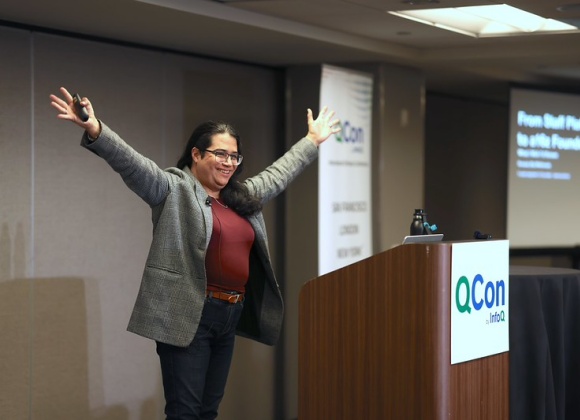This is the Engineering Culture Podcast, from the people behind InfoQ.com and the QCon conferences.
In this podcast recorded in London Shane Hastie, InfoQ Lead Editor for Culture & Methods, spoke to Chris Matts “The IT Risk Manager”, one of the original thinkers behind Real Options, Feature Injection and Behaviour Driven Development.
Key Takeaways
- Real Options is about translating the ideas from financial risk management into IT projects
- Understanding that things go wrong and that what is thought of as the last responsible moment is often actually too late and is in fact an irresponsible moment
- Most of the challenges to agile adoption are far above the level of the delivery team
- Introducing a simple governance framework which supports an agile culture
- The difference between the community of needs and the community of solutions, and the need for both
Subscribe on:
Show Notes
00m:30s Introductions
00m:55s Real Options is about translating the ideas from financial risk management into IT projects
01m:50s The intent behind Real Options is to manage risk rather than ignoring it.
02m:10s Three simple rules of Real Options
- Options have value
- Options expire
- Never commit early, unless you know why
02m:25s The fourth rule which is not often discussed – the value of options increases with uncertainty
02m:35s Explaining how real options can be used in decision making
03m:10s The mistaken perception that making a decision is making progress, even if the decision is a bad one
03m:50s Knowing the point at which options expire and the default action will happen regardless of the value
04m:20s Understanding that things go wrong and that what is thought of as the last responsible moment is often actually too late and is in fact an irresponsible moment
05m:25s Options give us choices
06m:00s Implementing cultural change using a risk management framework
06m:15s The importance of a governance framework
06m:50s Four elements of a lightweight governance framework for agile projects
- Deliver measurable value
- Reduce lead times
- Ensure sustainable quality
- Manage risk
08m:40s Using the culture to change the culture – the framework forces a change in focus from business to outcomes
09m:10s Cynefin – moving from complicated to complex solutions
09m:45s Embracing uncertainty and focusing on valuable outcomes
10m:20s Changing the metrics from features and effort to outcomes and customer value
11m:25s Most of the challenges to agile adoption are far above the level of the delivery team
12m:25s Changing the lead time measurement to reflect the entire value stream through to getting value from the features in the hands of real customers
13m:40s The need to break work into very small pieces
14m:05s Design metrics such that when people game the metric they exhibit the behaviour you want to see
14m:15s Example of how a lead time metric can influence the size of features
14m:40s Example of how a “concept to cash” metric can cause the wrong behaviours
16m:30s The backlog at the portfolio level needs to be ordered
17m:40s A mechanism to order the portfolio
18m:15s The real constraint in most organisations is capacity within teams rather than budget or time
18m:45s Prioritise the work at the constraint, capacity planning or delivery mapping
20m:00s Application of Theory of Constraints
20m:40s Culture in the agile community
21m:00s There are two broad communities that agile practitioners span–
- Community of needs
- Community of solutions
21m:15s Community of needs is identifying problems which don’t have well established solutions and create solutions through experimentation and learning, then sharing the ideas with others
21m:25s Community of solutions is able to apply solutions which have been identified through the community of needs
22m:35s Example of Scrum and Kanban crossing the chasm and becoming part of the community of solutions
22m:50s The two communities have very different behaviours.
22m:55s Community of needs events tend to be peer to peer and collaborative
23m:25s Community of solutions events are more expert driven, classroom style
24m:15s Many of the agile events and commences are in the community of solutions now
24m:25s The need for a strong focus on the community of needs to conduct experiments, learn new things and develop new solutions, especially around scaling agile
24m:50s Example of how the risk framework didn’t work in a particular context and how that made the approach more robust through identifying the context for failure
25m:50s Agile at scale is still in the experimental and learning stage
26m:50s The risk of losing credibility through unrealistic expectations and not understanding the organisational context
27m:25s Questioning if some of the frameworks are in line with the agile manifesto
27m:35s Uncovering better ways of developing software by doing it and helping others do it
28m:00s Adopting practices because they are proven in many contexts, not because they sell well
Mentioned:



